Pleurodeles waltl is a large species with interesting behaviors.
The words that came to mind when I saw my first Spanish ribbed newts (Pleurodeles waltl) at a local pet shop years ago were “large and impressive.” The owner advised that they were easy to keep, captive bred, fully aquatic and raised on pelleted newt food. Spanish ribbed newts are the largest European newt species and one of the largest newts in the world. They commonly grow to exceed 8 inches in captivity and are available in two colors: normal (the wild type) and leucistic, which is pinkish white.
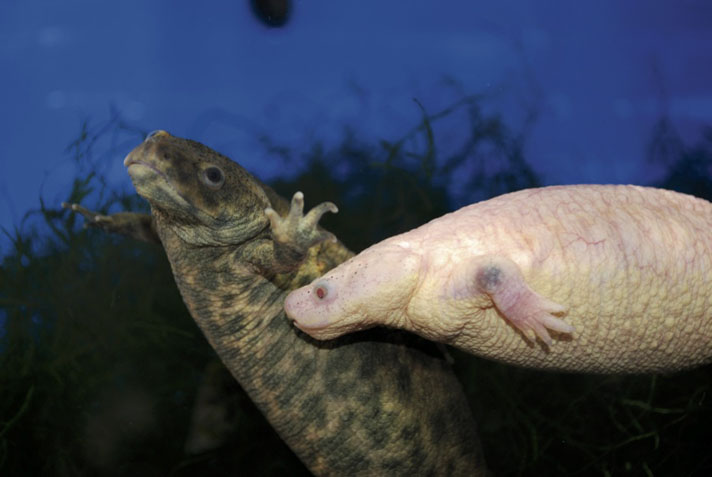
russ beasty
Both normal and leucistic Spanish ribbed newts are currently available to hobbyists.
The Nearly Threatened Spanish Ribbed Newt
Spanish Ribbed newts are native to the Iberian Peninsula and the coastal areas of northwestern Morocco. They usually inhabit small ponds, marshes and slow-moving streams, preferring calm water with very little current. During the day they hide among aquatic plants and in submerged leaf litter.
In 2006, the Spanish ribbed newt was listed as Near Threatened by the International Union for Conservation of Nature (IUCN). More recent reports indicate that populations have disappeared in several regions where they were historically abundant, partially due to habitat destruction, pollution, agricultural runoff and the introduction of several invasive species that prey on the newt’s eggs and larvae.
Ribbed newts have been bred and raised in laboratories for more than a century, and they are commonly used in experimental studies that involve organ regeneration and zero-gravity testing.
The Spanish ribbed newt is a large, robust species with dark, olive-brown, rough, granular skin that exhibits irregular black spots and blotches. Wild specimens have been recorded growing up to 12 inches in length, but most captive-bred animals will reach a maximum length of 8 to 9 inches.
A ribbed newt’s head is broad, laterally compressed and very muscular. The eyes are located near the top of the head and positioned slightly forward. Both males and females possess dorsal and ventral tail crests, with the male’s tail being disproportionately longer to its body length. Sexually mature male and female newts have very different body structures, so determining their sex is very easy. Male ribbed newts have comparatively slender bodies with narrow heads in comparison to the females. They also possess very long forelimbs, which look disproportionate to the rest of the body. Females have large broad heads with an overall stockier build, especially when they are full of eggs. Their forelimbs are much shorter than the males’ and look more in balance with the rest of their body. Newts in their juvenile “eft” stage are impossible to sex, because sexual characteristics don’t develop until they reach maturity at about 10 months of age, but when you observe mature newts together, the differences are quite apparent.
Spanish Ribbed Newt Housing
Most ribbed newts offered for sale are usually in their aquatic eft stage and are between 3 and 5 months of age. At this stage they have lost their external gills, dorsal and ventral tail crests and resemble 3- to 4-inch-long terrestrial salamanders. This is a perfect age and size at which to obtain your new pet, because at this stage they will readily accept commercial newt pellets and no longer require live food.
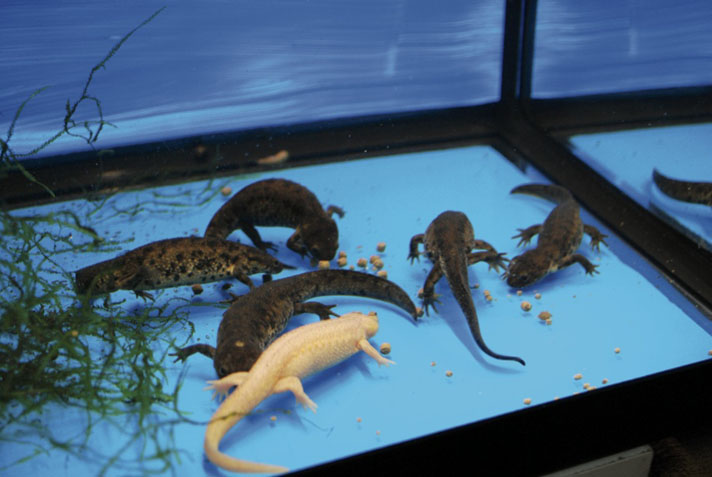
russ beasty
If tank size permits, groups of eight to 12 ribbed newts of similar size can be housed together.
Ribbed newts can be purchased online or in pet stores that stock exotic pets. If your goal is to eventually breed the newts, and mature adults that can be sexed are not available, if you purchase at least three or more juveniles you will likely ensure that you obtain at least one pair. Any extra newts can easily be sold to a local pet store or online, if desired.
I keep my adult pairs in standard 10-gallon aquariums, each containing about 8 gallons of water, bringing the water level to about 2 inches from the top of the tank. The tanks contain no substrate, filters or heaters, and the outside bottoms are painted black or blue with acrylic paint to reduce reflection. The tanks are kept in a room that receives at least 12 hours of ambient light, with a seasonal temperature fluctuation between 65 and 80 degrees Fahrenheit. Included in each of my newt tanks is 3 to 4 inches of live Java moss (Vesicularia dubyana), a very hardy, free-floating aquatic moss that does well in a wide range of water conditions and light levels.
Though a cover wouldn’t hurt, my tanks do not have covers and I have never had a ribbed newt escape using this type of arrangement. Whether you use a tank cover or not, remember to only fill newt tanks to within 2 inches from the top to prevent any escapes.
Tanks receive weekly water changes of at least 50 percent, accomplished by siphoning mulm and waste from the bottom and refilling the tanks with non-chlorinated tap water that is about the same temperature as the remaining water in the tanks. This method has worked well over the long term, and it provides the newts with clean water, lots of cover and calm water conditions. Plus, tanks kept in this fashion can be serviced and cleaned relatively quickly without causing much of a disturbance to the inhabitants.
An alternative set-up to house one or two newts would be a 10-gallon tank, mechanical filtration and a lighted tank hood. If you choose to use a larger aquarium and want to keep more than two newts, allow at least 4 to 5 gallons for each additional newt. Either an internal or external power-type mechanical filter or an air-driven sponge or box type filter can be used to help maintain water quality. In both cases you could lessen water current by strategically placing tank decorations near the filter’s water return, or minimizing the air flowing through the sponge or box filter so it causes less water disturbance.
No special lighting is required for ribbed newts, but if you use a lighted tank canopy, arrange floating plants to diffuse and soften the amount of light that is penetrating into the aquarium. Otherwise, bright overhead lighting could cause your newts to remain hidden during the day. Use fluorescent or LED lights, too, because incandescent lamps will raise the water temperature.
If you choose to use a substrate for a more natural-looking tank, use sand or a large, coarse gravel. Newts might ingest the typical pea-sized aquarium gravel, which could lead to serious health issues.
Ribbed newts prefer plants, live or plastic, over other types of tank decorations. Always incorporate a few vertically oriented plants as well as some ground cover. They seem to like resting in plants in a near-vertical position, while peering at the water’s surface. Newts that feel threatened in any way will be able to hide in the ground cover you provide, which helps them feel secure.
Ideal Water Conditions for the Spanish Ribbed Newt
Regardless of the tank size you decide to use, whether the minimum 10 gallon or a larger enclosure, the emphasis should always be on maintaining water quality. The survival and health of your pet newt will depend largely on the quality of the water.
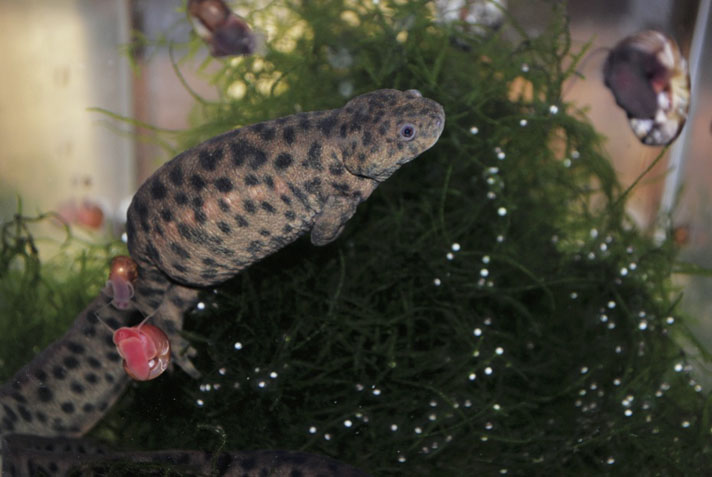
russ beasty
Always incorporate a few vertically oriented plants as well as some ground cover. They seem to like resting in plants in a near-vertical position, while peering at the water’s surface.
There are several ways to maintain optimal water conditions for your pet newts. Allow a minimum of one week for a newly set up aquarium to run before adding newts. This will give the beneficial bacteria a chance to become established, which will aid in the breakdown of waste produced by the newts. The longer an aquarium is running the more efficient it becomes at processing waste, as the bacteria colonies grow in number and become established.
Follow the proper density/volume ratios in your aquatic habitats. If you have the maximum number of newts in the minimum amount of water volume, it will be harder to maintain stable water conditions. Allow a minimum of 4 to 5 gallons of water per newt. Routine water changes of at least 10 percent conducted on a weekly basis are the best way to keep acceptable water conditions from degrading over time. Use non-chlorinated water that is about the same temperature as the tank water you’re replacing. To ensure replacement water is dechlorinated, either let it sit out for 24 hours, or add a water conditioner such as AmQuel Plus, SafeStart, etc., which will remove potentially harmful components from tap water and make it safe for aquatic life. Look for these types of products in pet stores that sell tropical fish supplies.
Keep your newts on a feeding schedule, with one person in charge of feeding. Overfeeding can lead to high bacteria and water-quality issues, which will compromise your newt’s immune system. Remove any uneaten food items within 30 minutes after feeding. Never add food to a tank that has a foul odor or cloudy water. Do a 20- to 30-percent water change and wait 48 hours before offering food.
Juvenile ribbed newts will consume several small feedings on a daily basis, while adults, unless they’re being conditioned for breeding, can be fed once every other day. It is a good idea to incorporate at least one fasting day per week for young animals that are being fed daily, preferably on the day you conduct their weekly water change. A hungry newt swimming in clean, clear water will be healthier than an overfed newt swimming in cloudy, polluted water among leftover food.
Ideal Temperature for the Spanish Ribbed Newt
Spanish ribbed newts can handle a wide range of water temperatures, but do best between 66 and 74 degrees. If your newts are healthy and the water quality is good, temperatures outside this range can be tolerated without causing any health problems. If the water temperature rises into the mid to high 80s for a prolonged period, however, carefully remove the newts and put them in a temporary holding container in a cooler location. Small, plastic storage containers with a couple inches of cool water inside will work well.
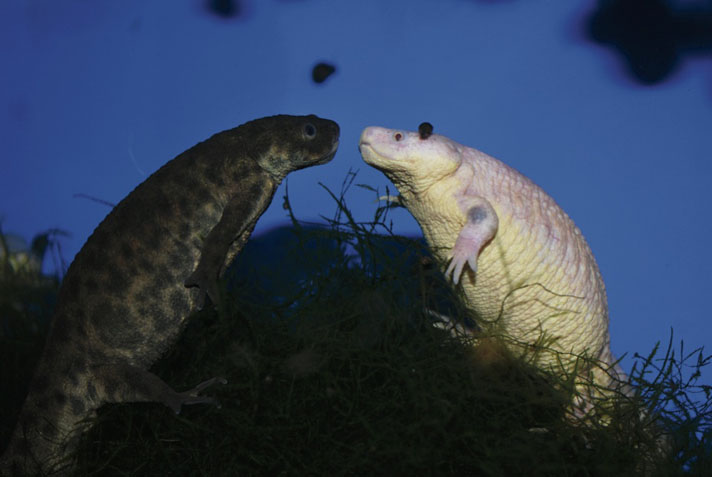
russ beasty
Spanish ribbed newts can handle a wide range of water temperatures, but do best between 66 and 74 degrees.
Temperature extremes on the cooler end of the range are not a problem; ribbed newts can handle temperatures down into the mid 40s without suffering any health problems.
Avoid placing your newt enclosure anywhere near direct sunlight, as this will heat up the water.
Spanish Ribbed Newt Tankmates
If tank size permits, groups of eight to 12 ribbed newts of similar size can be housed together. Don’t keep them with any other species of newt; most of the other newts available are much smaller than adult ribbed newts, and they might be mistaken for a meal, or serious fighting might take place.
You can keep ribbed newts with fish, but choose wisely. Keeping them in a tank with Oscars or other large cichlids—or any other large, aggressive, predatory fishes—will not work for obvious reasons. I have kept ribbed newts with guppies, mollies and platies without a problem, but remember that these newts are capable of swallowing anything that will fit in their mouths. Avoid small catfishes because they would mostly occupy the bottom of the aquarium where the newts would commonly feed. There have been accounts of dead Corydoras catfish found lodged in the mouths of dead newts, so avoid any species of bottom-feeding catfishes.
Want To Learn More?
I keep domestically bred ramshorn snails (Planorbarius corneus) in all my ribbed newt tanks. They are a good choice for several reasons. Snails are a great indicator species of water quality. If water quality starts to degrade and there is a need for water change, snails will act lethargic and hang on the glass near the water’s surface. They will also start dying off before amphibians and fish are affected. Snails will not compete with the newts while they’re feeding, but will locate and consume leftover food items that might have gone undetected and left to foul the water.
What to Feed Spanish Ribbed Newts
Feeding ribbed newts is very easy. I have raised them from juveniles to healthy adults in less than 10 months while feeding them exclusively on commercial newt or aquaculture pellets of the sinking variety. There are several types available at pet stores and online.
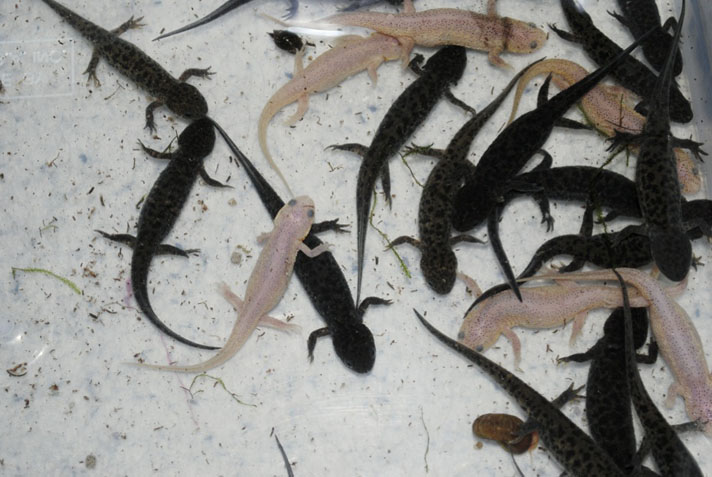
russ beasty
Most ribbed newts offered for sale are usually in their aquatic eft stage and are between 3 and 5 months of age.
If you can’t obtain food specifically designed for newts, any type of sinking, pelleted fish food with a protein content that’s between 40 and 50 percent will work fine. Juvenile newts from 3 to 5 inches do well on pellets that are about the same size as a half a grain of rice. Adults can consume pellets up to the size of a pea.
Ribbed newts will also readily devour frozen bloodworms, frozen adult brine shrimp, live earthworms, blackworms and white worms. Make sure the food items offered are appropriate for the size of your newt. Always feed sparingly, until you can establish the proper amount that your newt(s) will consume in about 20 minutes. As mentioned, incorporate fasting days into the feeding routine so both the newts and the water quality will be healthier.
Spanish ribbed newts do well in captivity and can live more than 10 years if their basic requirements are provided. Within a short period of time they usually become very responsive and trusting enough to take food from your fingers. Their large size, friendly personality and easy care requirements make them a perfect choice for both beginners and experienced hobbyists.
Russ Beasty has been interested in amphibians and reptiles for more than four decades. In addition to ribbed newts, his current breeding projects include several species of geckos, skinks and snakes. Check out his website at stickylizards.com.


